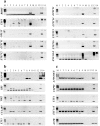A gene catalogue of the euchromatic male-specific region of the horse Y chromosome: comparison with human and other mammals
- PMID: 21799735
- PMCID: PMC3143126
- DOI: 10.1371/journal.pone.0021374
A gene catalogue of the euchromatic male-specific region of the horse Y chromosome: comparison with human and other mammals
Abstract
Studies of the Y chromosome in primates, rodents and carnivores provide compelling evidence that the male specific region of Y (MSY) contains functional genes, many of which have specialized roles in spermatogenesis and male-fertility. Little similarity, however, has been found between the gene content and sequence of MSY in different species. This hinders the discovery of species-specific male fertility genes and limits our understanding about MSY evolution in mammals. Here, a detailed MSY gene catalogue was developed for the horse--an odd-toed ungulate. Using direct cDNA selection from horse testis, and sequence analysis of Y-specific BAC clones, 37 horse MSY genes/transcripts were identified. The genes were mapped to the MSY BAC contig map, characterized for copy number, analyzed for transcriptional profiles by RT-PCR, examined for the presence of ORFs, and compared to other mammalian orthologs. We demonstrate that the horse MSY harbors 20 X-degenerate genes with known orthologs in other eutherian species. The remaining 17 genes are acquired or novel and have so far been identified only in the horse or donkey Y chromosomes. Notably, 3 transcripts were found in the heterochromatic part of the Y. We show that despite substantial differences between the sequence, gene content and organization of horse and other mammalian Y chromosomes, the functions of MSY genes are predominantly related to testis and spermatogenesis. Altogether, 10 multicopy genes with testis-specific expression were identified in the horse MSY, and considered likely candidate genes for stallion fertility. The findings establish an important foundation for the study of Y-linked genetic factors governing fertility in stallions, and improve our knowledge about the evolutionary processes that have shaped Y chromosomes in different mammalian lineages.
Conflict of interest statement
Figures




References
-
- Skaletsky H, Kuroda-Kawaguchi T, Minx PJ, Cordum HS, Hillier L, et al. The male-specific region of the human Y chromosome is a mosaic of discrete sequence classes. Nature. 2003;423:825–837. - PubMed
-
- Graves JA. Sex chromosome specialization and degeneration in mammals. Cell. 2006;124:901–914. - PubMed
-
- Grzmil P, Golas A, Muller C, Styrna J. The influence of the deletion on the long arm of the Y chromosome on sperm motility in mice. Theriogenology. 2007;67:760–766. - PubMed
Publication types
MeSH terms
Substances
LinkOut - more resources
Full Text Sources

